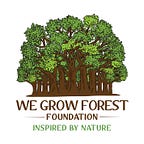THE FIGHTING CARBON SINKS
In recent years, we have been experiencing increased instances of extreme events such as heatwaves, wildfires, droughts, and floods across the globe. You might be thinking, isn’t this something happening in another place, and how does this concern me? This summer has been the hottest summer so far for India. We have been experiencing increased instances of Heat Waves around us. It is all part of the more significant problem of climate change.
What might be causing this?
When you look deeper into the problem, one of the primary reasons is the increase of certain greenhouse gases such as carbon dioxide in the atmosphere. Carbon, as such, is not a culprit. Even before these issues, Carbon was produced due to natural processes such as plant/ animal respiration, volcanic eruptions, and forest fires.
Natural carbon sequestration has occurred throughout much of Earth’s history. It is the natural mechanism by which the Earth’s atmosphere is kept in a state of carbon dioxide equilibrium that best supports life.
Why are Forests important?
From the oxygen we breathe to the wood we consume, we rely on forests for our life. Aside from providing habitat for wildlife and a source of income for humans, Forests, after oceans, are the world’s greatest carbon sinks. Forests are one of the significant carbon sinks in the natural process. Forests sequester or store carbon mainly in trees and soil. Forests absorb about 2.6 billion tones of carbon dioxide every year, accounting for one-third of the CO2 emitted by burning fossil fuels. It is absorbed and stored in the form of trees, plants, and decaying plant debris in the soil.
The green lungs
Trees are one of the best carbon sequestration methods available. They take carbon dioxide from the air, bind it to sugar, and release oxygen when they complete photosynthesis.
Trees use sugar to make wood, branches, and roots. Because wood is totally comprised of carbon, it is an excellent carbon sink because it lasts for years as a standing tree and takes years to decompose once it dies.
Depending on the average age of the trees in the stand and the number of trees in the stand, forests capture and store varying amounts of carbon at different rates.
Young woods have many trees and are good at absorbing carbon. Young trees grow swiftly and can quickly absorb carbon. As the tree grows, they sequester more carbon as the forest matures.
The source and the circuit
Apart from trees, carbon is also stored in the soil in forests. The quantity of carbon retained in forest soils varies depending on various local characteristics such as geology, soil type, and vegetation. Clay soils have the potential to bind high quantities of carbon as opposed to sandy soils. Soils that contain more organic material can store more carbon. Likewise, soils containing more organic material (pieces of wood, rotting leaves, or dead organisms) can store more carbon.
Forests are excellent at trapping significant amounts of carbon and storing it for a long time. However, carbon in forests is eventually released into the atmosphere through decomposition, respiration, and other natural processes. Some places are better than others in storing carbon over lengthy periods. For an extended period, the carbon that makes up a mature tree’s centre remains bound until the tree dies and decomposes. Depending on how long the tree has been alive, this process can take decades to millennia.
While carbon sequestration in trees is natural, forest management can encourage trees to retain more carbon. An essential strategy is to preserve the natural state of the woods. Carbon is released when forests are converted for other land uses, and the land’s ability to store carbon is lost.
What can be done?
Forests help foster sustainable growth by regulating ecosystems, protecting biodiversity, playing an essential role in the carbon cycle, and supporting livelihoods.
We need to combat deforestation and forest degradation. Steps are needed to prevent the degradation of many of the world’s natural ecosystems and their ability to store carbon efficiently. The forest landscapes that are degraded need to be restored.
The key is to use planning and management strategies that help capture additional carbon while minimising losses of stored carbon. Organisations like We Grow Forest Foundation can help guide you through these processes to tap into the potential of forests.
To know more about We Grow Forest Foundation please visit our website https://wegrowforest.org/ or contact us at on 9778411911 or email at us plant@wegrowforest.org
